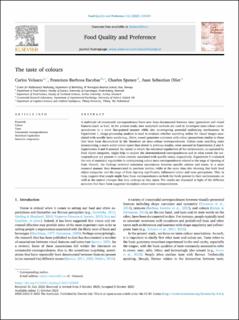| dc.description.abstract | A multitude of crossmodal correspondences have now been documented between taste (gustation) and visual features (such as hue). In the present study, new analytical methods are used to investigate taste-colour correspondences in a more fine-grained manner while also investigating potential underlying mechanisms. In Experiment 1, image processing analysis is used to evaluate whether searching online for visual images associated with specific taste words (e.g., bitter, sweet) generates outcomes with colour proportions similar to those that have been documented in the literature on taste–colour correspondences. Colour–taste matching tasks incorporating a much wider colour space than tested in previous studies, were assessed in Experiments 2 and 3. Experiments 3 and 4 assessed the extent to which the statistical regularities of the environment, as captured by food object categories, might help to explain the aforementioned correspondences and to what extent the correspondences are present in online content associated with specific tastes, respectively. Experiment 5 evaluated the role of statistical regularities in underpinning colour-taste correspondences related to the stage of ripening of fruit. Overall, the findings revealed consistent associations between specific colours and tastes, in a more nuanced manner than demonstrated in previous studies, while at the same time also showing that both food object categories and the stage of fruit ripening significantly influenced colour and taste perceptions. This, in turn, suggests that people might base these correspondences on both the foods present in their environments, as well as the natural changes that they undergo as they ripen. The results are discussed in light of the different accounts that have been suggested to explain colour-taste correspondences. | en_US |

